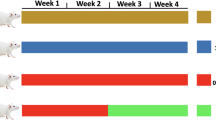Abstract
Sepsis-induced myocardial injury (SIMI) is caused by various mechanisms. The aim of this study was to investigate the effects of salidroside (Sal) on SIMI and its mechanisms in rats. The sepsis model was established by intraperitoneal injection of lipopolysaccharide (LPS) (15 mg/kg in sterile saline). Sal decreased the serum levels of creatine kinase (CK), lactate dehydrogenase (LDH), tumor necrosis factor-α (TNF-α), interleukin-6 (IL-6), and interleukin-1β (IL-1β), whereas the expressions of insulin-like growth factor-1 (IGF-1) signaling-related proteins, such as IGF-1 and its corresponding receptor (IGF-1R), phosphatidylinositol 3-kinase (PI3K), p-PI3K, Akt, p-Akt, and glycogen synthase kinase-3β (GSK-3β), in the heart were decreased with Sal pretreatment. Mitigated myocardial cell swelling, degeneration, loss of transverse striations, and inflammatory cell infiltration were also observed in the LPS + Sal groups. Thus, Sal is assumed to exert pronounced cardioprotective effects in rats subjected to LPS, probably through regulation of IGF-1/PI3K/Akt/GSK-3β signaling.





Similar content being viewed by others
References
Dellinger, R.P. 2013. The surviving sepsis campaign: 2013 and beyond. Chinese Medical Journal 126: 1803–1805.
Li, Z.Q., X.M. Xi, X. Luo, J. Li, and L. Jiang. 2013. Implementing surviving sepsis campaign bundles in China: a prospective cohort study. Chinese Medical Journal 126: 1819–1825.
Li, L., B.C. Hu, C.Q. Chen, and S.J. Gong. 2013. Role of mitochondrial damage during cardiac apoptosis in septic rats. Chinese Medical Journal 126: 1860–1866.
Balija, T.M., and S.F. Lowry. 2011. Lipopolysaccharide and sepsis-associated myocardial dysfunction. Current Opinion in Infectious Diseases 24: 248–253.
Tomita, N., R. Morishita, Y. Taniyama, H. Koike, M. Aoki, H. Shimizu, et al. 2003. Angiogenic property of hepatocyte growth factor is dependent on upregulation of essential transcription factor for angiogenesis, ets-1. Circulation 107: 1411e7.
Suleiman, M.S., R.J. Singh, and C.E. Stewart. 2007. Apoptosis and the cardiac action of insulin-like growth factor I. Pharmacology and Therapeutics 114: 278e94.
Wang, Y., N. Ahmad, M.A. Wani, and M. Ashraf. 2004. Hepatocyte growth factor prevents ventricular remodeling and dysfunction in mice via Akt pathway and angiogenesis. Journal of Molecular and Cellular Cardiology 37: 1041e52.
Li, Q., B. Li, X. Wang, A. Leri, K.P. Jana, Y. Liu, et al. 1997. Overexpression of insulin-like growth factor-1 in mice protects from myocyte death after infarction, attenuating ventricular dilation, wall stress, and cardiac hypertrophy. The Journal of Clinical Investigation 100: 1991e9.
Giuseppe, Lembo, Howard A. Rockman, John J. Hunter, et al. 1996. Elevated blood pressure and enhanced myocardial contractility in mice with severe IGF-1 deficiency. The Journal of Clinical Investigation 98: 2648–2655.
Wahlander, H., J. Isgaard, E. Jennische, and P. Friberg. 1992. Left ventricular insulin-like growth factor I increases in early renal hypertension. Hypertension 19: 25–32.
Donohue, T.J., L.D. Dworkin, M.N. Lango, K. Fliegner, R.P. Lango, J.A. Benstein, W.R. Slater, and V.M. Catanese. 1994. Induction of myocardial insulin-like growth factor-I gene expression in left ventricular hypertrophy. Circulation 89: 799–809.
Lovell, Matthew J., Yasin Mohammed, Kate L. Lee, et al. 2010. Bone marrow mononuclear cells reduce myocardial reperfusion injury by activating the PI3K/Akt survival pathway. Atherosclerosis 213: 67–76.
Cao, Zhijuan, Danyang Ren, Tuanzhu Ha, et al. 2013. CpG-ODN, the TLR9 agonist, attenuates myocardial ischemia/reperfusion injury: involving activation of PI3K/Akt signaling. Biochimica et Biophysica Acta 1832: 96–104.
Xu, J., and Y. Li. 2012. Effects of salidroside on exhaustive exercise-induced oxidative stress in rats. Molecular Medicine Reports 6: 1195–1198.
Huang, S.-C., F.-T. Lee, T.-Y. Kuo, et al. 2009. Attenuation of long-term Rhodiola rosea supplementation on exhaustive swimming-evoked oxidative stress in the rat. Chinese Journal of Physiology 52: 316–324.
Yan, T.-H., B.-S. Du, W. Yang, et al. 2008. Effects of salidroside on hemorheology and myocardial ischemic reperfusion injury in isolated heart of rats. Chinese Journal of Natural Medicines 6: 219–222.
Yan, T.H., Y. Ma, W. Yang, et al. 2009. Protective effects of salidroside on acute myocardial ischemia of rats and neonatal rat cardiocytes. Lishizhen Medicine and Materia Medica Research 20: 693–695.
Frolkis, I., Y. Klein, C. Locker, et al. 2010. Vipera aspis venom reduces lethality and down-regulates tumor necrosis factor-alpha in a rat model of LPS-induced sepsis. Cytokine 49: 319–324.
Tsai, W.H., P.Y. Cheng, Y.M. Lee, et al. 2008. Anti-inflammatory effects of LK-3, on LPS-induced sepsis in rats. The Chinese Journal of Physiology 51: 292–300.
Willerson, J.T., and P.M. Ridker. 2004. Inflammation as a cardiovascular risk factor. Circulation 109: II2–II10.
Cheng, Z., G. Li-Sha, Z. Jing-Lin, et al. 2014. Protective role of the cholinergic anti-inflammatory pathway in a mouse model of viral myocarditis. PLoS One 9: e112719.
Ungvari, Z., and A. Csiszar. 2012. The emerging role of IGF-1 deficiency in cardiovascular aging: recent advances. The Journals of Gerontology. Series A, Biological Sciences and Medical Sciences 67: 599–610.
Rong, S.L., Y.J. Wang, X.L. Wang, et al. 2010. Recombinant proteins secreted from tissue-engineered bioartificial muscle improve cardiac dysfunction and suppress cardiomyocyte apoptosis in rats with heart failure. Chinese Medical Journal 123: 2633–3626.
Zhu, L., T. Wei, X. Chang, H. He, et al. 2015. Effects of salidroside on myocardial injury in vivo in vitro via regulation of Nox/NF-κB/AP1 pathway. Inflammation. doi:10.1007/s10753-015-0134-0.
Song, F., H. Li, J. Sun, and S. Wang. 2013. Protective effects of cinnamic acid and cinnamic aldehyde on isoproterenol-induced acute myocardial ischemia in rats. Journal of Ethnopharmacology 150: 125–130.
Metsuzaki, H., M. Tamatani, N. Mistuda, et al. 2004. Activation Akt kinase inhibits apoptosis and changes in bcl-2 and Bax expression induced by nitric oxide in primary hippocampal neurons. Journal of Neurochemistry 73: 2037–2046.
Acknowledgments
This work was supported by the National Twelve Five Major Drug Discovery Project (2011ZX09102-002-01).
Author information
Authors and Affiliations
Corresponding authors
Rights and permissions
About this article
Cite this article
He, H., Chang, X., Gao, J. et al. Salidroside Mitigates Sepsis-Induced Myocarditis in Rats by Regulating IGF-1/PI3K/Akt/GSK-3β Signaling. Inflammation 38, 2178–2184 (2015). https://doi.org/10.1007/s10753-015-0200-7
Published:
Issue Date:
DOI: https://doi.org/10.1007/s10753-015-0200-7




